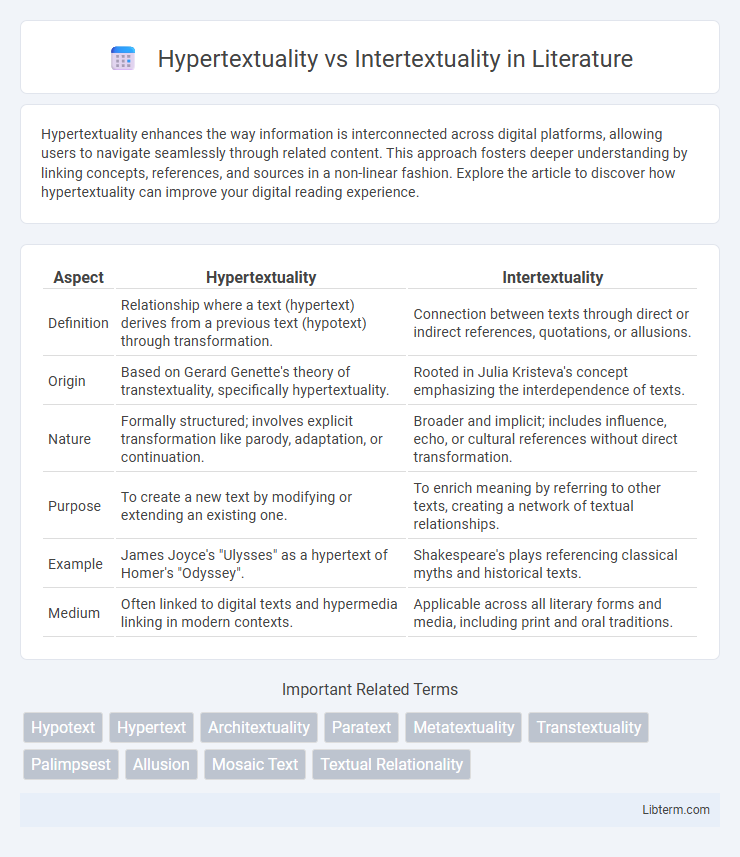Hypertextuality enhances the way information is interconnected across digital platforms, allowing users to navigate seamlessly through related content. This approach fosters deeper understanding by linking concepts, references, and sources in a non-linear fashion. Explore the article to discover how hypertextuality can improve your digital reading experience.
Table of Comparison
| Aspect | Hypertextuality | Intertextuality |
|---|---|---|
| Definition | Relationship where a text (hypertext) derives from a previous text (hypotext) through transformation. | Connection between texts through direct or indirect references, quotations, or allusions. |
| Origin | Based on Gerard Genette's theory of transtextuality, specifically hypertextuality. | Rooted in Julia Kristeva's concept emphasizing the interdependence of texts. |
| Nature | Formally structured; involves explicit transformation like parody, adaptation, or continuation. | Broader and implicit; includes influence, echo, or cultural references without direct transformation. |
| Purpose | To create a new text by modifying or extending an existing one. | To enrich meaning by referring to other texts, creating a network of textual relationships. |
| Example | James Joyce's "Ulysses" as a hypertext of Homer's "Odyssey". | Shakespeare's plays referencing classical myths and historical texts. |
| Medium | Often linked to digital texts and hypermedia linking in modern contexts. | Applicable across all literary forms and media, including print and oral traditions. |
Understanding Hypertextuality: A Digital Evolution
Hypertextuality represents a digital evolution where texts are interconnected through hyperlinks, enabling nonlinear navigation and user-driven exploration of content, contrasting with intertextuality's emphasis on the relationship and referencing between texts in a traditional literary context. This digital framework transforms reading into an interactive experience, enhancing comprehension by allowing immediate access to related information and multimedia resources. Hypertextuality's role in digital environments revolutionizes how information is structured, accessed, and understood, fostering dynamic knowledge acquisition beyond linear narratives.
Defining Intertextuality: Origins and Core Concepts
Intertextuality, a concept introduced by Julia Kristeva in the 1960s, explores the interconnectedness of texts through the shaping of meaning by other texts, emphasizing that no text exists in isolation. Rooted in Mikhail Bakhtin's theories, intertextuality highlights how all literary works are mosaics of quotations, transforming and integrating previous narratives, genres, and styles. This core concept underscores the dialogic nature of literature, where understanding emerges from recognizing echoes, references, and influences across a web of textual relationships.
Historical Context: From Textual Theory to Hyperlinks
Hypertextuality emerged from the evolution of textual theory, transforming linear texts into interconnected digital webs through hyperlinks. Intertextuality, rooted in literary theory, examines how texts reference or influence each other within cultural and historical contexts. The shift from intertextuality to hypertextuality marks a significant historical transition from traditional narrative structures to dynamic, non-linear digital networks enabled by the internet.
Hypertextuality in Digital Media
Hypertextuality in digital media refers to the organization and presentation of content through interconnected links that enable nonlinear navigation and interactive user experiences. This structure enhances content accessibility and engagement by allowing users to explore related information dynamically across websites, multimedia platforms, and digital documents. Unlike intertextuality, which involves textual relationships and references, hypertextuality emphasizes the technical linking mechanisms that form the backbone of digital communication and knowledge dissemination.
Classic Examples of Intertextuality in Literature
Classic examples of intertextuality in literature include James Joyce's "Ulysses," which intricately references Homer's "Odyssey," creating a layered narrative that resonates with mythological undertones. T.S. Eliot's poem "The Waste Land" extensively incorporates quotations and allusions from various texts, including Shakespearean works and religious scriptures, enriching its thematic complexity. These instances highlight intertextuality's role in deepening textual meaning by embedding dialogues with prior literary works, distinct from hypertextuality's digital linking of texts.
Key Differences Between Hypertextuality and Intertextuality
Hypertextuality involves digital texts linked through clickable connections, enabling nonlinear navigation across various documents or media, whereas intertextuality refers to the literary or textual relationship where one text references or echoes another within its content. Key differences lie in hypertextuality's reliance on technological frameworks facilitating user interaction and navigation, contrasting with intertextuality's conceptual dependence on thematic, cultural, or textual references embedded in language and meaning. Hypertextuality functions primarily in digital environments enhancing reader interactivity, while intertextuality is a broader literary device impacting interpretation and understanding across different texts or media forms.
How Technology Shapes Hypertextuality
Technology revolutionizes hypertextuality by enabling non-linear navigation through digital content, enhancing user interaction with interconnected hyperlinks. Advanced web platforms and multimedia integration amplify associative connections, creating dynamic reading experiences beyond traditional linear texts. This technological framework fosters a richly layered semantic network, allowing users to explore information through diverse pathways.
Reader Engagement: Navigating Hypertext and Intertext
Hypertextuality enhances reader engagement by allowing users to actively navigate through linked texts, creating a nonlinear reading experience that encourages exploration and discovery. Intertextuality enriches comprehension by prompting readers to recognize references and connections between texts, fostering deeper analytical thinking. Both concepts rely on reader participation, but hypertextuality emphasizes interactive navigation, while intertextuality focuses on interpretive linkages within the literary context.
Applications in Modern Storytelling and Education
Hypertextuality enables interactive narratives by linking multiple digital texts, fostering nonlinear storytelling and enhancing user engagement in modern media such as e-books, websites, and educational platforms. Intertextuality enriches content through references, quotations, or stylistic echoes of other works, deepening comprehension and critical thinking within literature, film, and classroom discussions. Both techniques are integral to innovative pedagogical approaches, allowing immersive learning experiences that connect diverse sources and perspectives.
Future Perspectives: Blending Hypertextuality and Intertextuality
Future perspectives on blending hypertextuality and intertextuality emphasize creating dynamic digital narratives that interlink diverse textual references through interactive hyperlinks, enhancing user engagement and knowledge exploration. Advances in AI and semantic web technologies will enable more intuitive connections between texts, facilitating personalized and context-aware content navigation. This integration promises to transform traditional reading experiences into multisensory, nonlinear journeys through layered meanings and cross-referential networks.
Hypertextuality Infographic

 libterm.com
libterm.com